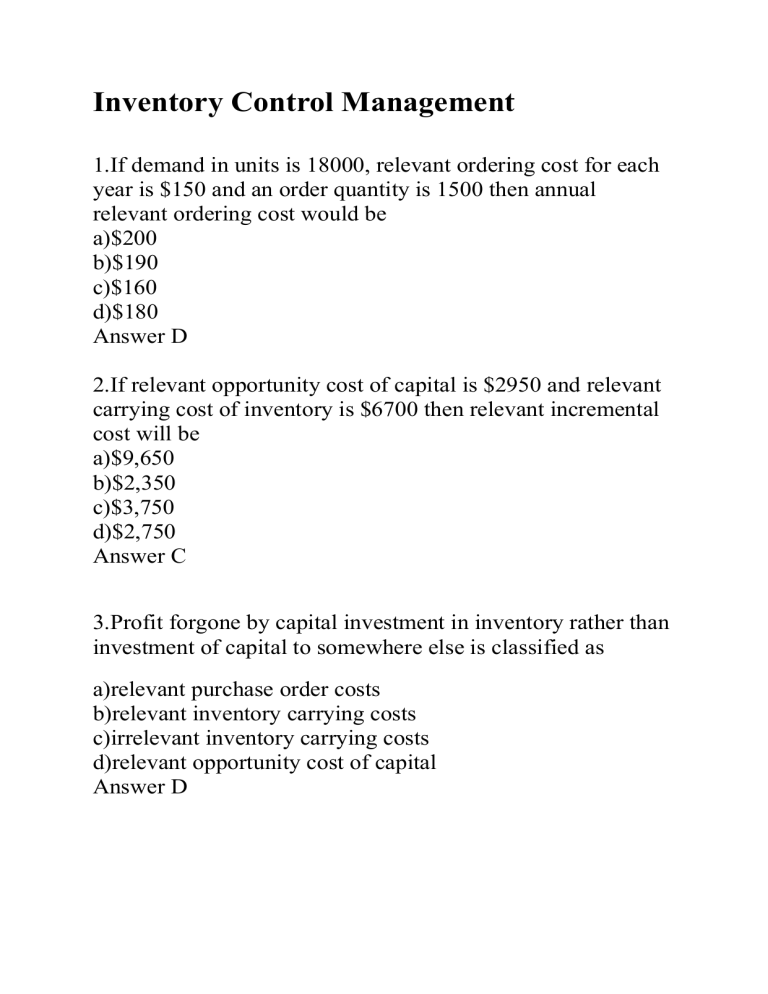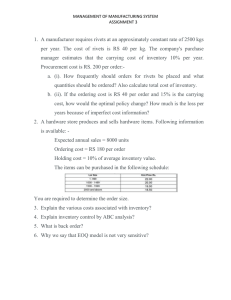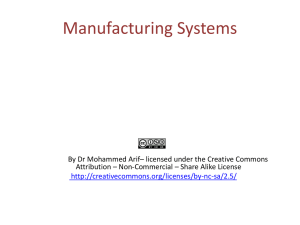
Inventory Control Management 1.If demand in units is 18000, relevant ordering cost for each year is $150 and an order quantity is 1500 then annual relevant ordering cost would be a)$200 b)$190 c)$160 d)$180 Answer D 2.If relevant opportunity cost of capital is $2950 and relevant carrying cost of inventory is $6700 then relevant incremental cost will be a)$9,650 b)$2,350 c)$3,750 d)$2,750 Answer C 3.Profit forgone by capital investment in inventory rather than investment of capital to somewhere else is classified as a)relevant purchase order costs b)relevant inventory carrying costs c)irrelevant inventory carrying costs d)relevant opportunity cost of capital Answer D 4. An example of shrinkage costs includes a)incoming freight b)storage costs c)insurance D)clerical errors Answer D 5.If relevant incremental costs are $5000 and relevant opportunity cost of invested capital is $2500 then relevant inventory carrying costs would be a) $7,500 b) $7,000 c) $6,500 d) $6,000 Answer A 6.Costing system which omits some of journal entries in accounting system is known as A)ain-time costing b)trigger costing c)back flush costing d)lead time costing Answer C 7.Decision model to calculate optimal quantity of inventory to be ordered is called a)efficient order quantity b)economic order quantity c)rational order quantity d)optimized order quantity Answer B 8.Stage in manufacturing cycle at which journal entries are made in system of accountancy is known as a)chaining point b)recording point c)lead point d)trigger point Answer D 9.If required rate of return is 12% and per unit cost of units purchased is $35 then relevant opportunity cost of capital will be a)$6.20 B)$7.20 c)$4.20 d)$5.20 Answer C 10. Method of costing that supports creation of value for customer by accounting whole value stream rather than individual departments or products is classified as a)economic accounting b)back-flush accounting c)lean accounting d)lead accounting Answer C 11.If purchase order lead time is 35 minutes and number of units sold per time is 400 units then reorder point will be a)14000 units b)14500 units c)15000 units d)15500 units Answer A 12.An example of purchasing costs include a)incoming freight B)storage costs C)insurance d)spoilage Answer C 13.If an average inventory is 2000 units and annual relevant carrying cost of each unit is $5 then annual relevant carrying cost will be a)$5,000 b)$4,500 c)$5,500 d)$6,000 Answer A 14.If demand of one year is 25000 units, relevant ordering cost for each purchase order is $210 and carrying cost of one unit of stock is $25 then economic order quantity is a)678 packages b)648 packages c)658 packages d)668 packages Answer B 15.Cost of product failure, error prevention and appraisals are classified as a)stocking costs b.stock-out costs c)costs of quality sh D)rinkage costs Answer C 16. Activities related to coordinating, controlling and planning activities of flow of inventory are classified as a)decisional management b)throughput management c)inventory management d)manufacturing management Answer C 17.Which of the following is true for Inventory control? a)Economic order quantity has minimum total cost per order b)Inventory carrying costs increases with quantity per order c)Ordering cost decreases with lo size d)All of the above (Ans:d) 18.The time period between placing an order its receipt in stock is known as a)Lead time b)Carrying time c)Shortage time d)Over time (Ans:a) 19.Re-ordering level is calculated as a)Maximum consumption rate x Maximum re-order period b)Minimum consumption rate x Minimum re-order period c)Maximum consumption rate x Minimum re-order period d)Minimum consumption rate x Maximum re-order period (Ans:a) 20.Average stock level can be calculated as a)Minimum stock level + ½ of Re-order level b)Maximum stock level + ½ of Re-order level c)Minimum stock level + 1/3 of Re-order level d)Maximum stock level + 1/3 of Re-order level (Ans:a) 1. Sixty percent of Basket Wonders’ annual sales of $900,000 is on credit. If its year-endreceivables turnover is 4.5, the average collection period and the year-end receivables are,respectively __________. (Assume a 365-day year.) A) 81 days and $120,000 B) 73 days and $120,000 C) 73 days and $108,000 D) 81 days and $108,000 Ans: A) 2. If EOQ = 40 units, order costs are $2 per order, and carrying costs are $.20 per unit, what is theusage in units? A) 10 units. B) 16 units. C) 40 units. D) 80 units. Ans: D) 3. If EOQ = 1,000 units, order costs are $200 per order, and sales total 5,000 units, what is thecarrying cost per unit? A) $2 B) $10 C) $100 D) $1000 Ans: A) 4. Which of the following statements hold true for safety stock? A) The greater the risk of running out of stock, the larger the safety stock needed. B) The lower the opportunity cost of the funds invested in inventory, the smaller the safety stockneeded. C) The greater the uncertainty associated with forecasted demand, the lower the level of safety stockneeded. D) The higher the profit margin per unit, the lower the safety stock necessary. Ans: A) 5. Which ratio might you be the most concerned with in analyzing a firm’s financial leverageposition? A) Return on equity. B) Debt-to-total assets. C) Acid-test. D) Inventory turnover. Ans: B) 6. Which of the following relationships hold true for safety stock? A) the greater the risk of running out of stock, the smaller the safety of stock. B) the larger the opportunity cost of the funds invested in inventory, the larger the safety stock. C) the greater the uncertainty associated with forecasted demand, the smaller the safety stock. D) the higher the profit margin per unit, the higher the safety stock necessary. Ans: D 7. Increasing the credit period from 30 to 60 days, in response to a similar action taken by all of our competitors, would likely result in: A) an increase in the average collection period. B) a decrease in bad debt losses. C) an increase in sales. D) higher profits. Ans: A 8. Receiving a required inventory item at the exact time needed. A) ABC B) JIT C) FOB D) PERT Ans: B 9. EOQ is the order quantity that over our planning horizon. A) minimizes total ordering costs B) minimizes total carrying costs C) minimizes total inventory costs D) the required safety stock Ans: B 10. The credit policy of Spurling Products is “1.5/10, net 35.” At present 30% of the customers take thediscount, 62% pay within the net period, and the rest pay within 45 days of invoice. What wouldreceivables be if all customers took the cash discount? A) Lower than the present level. B) No change from the present level. C) Higher than the present level. D) Unable to determine without more information. Ans: A



